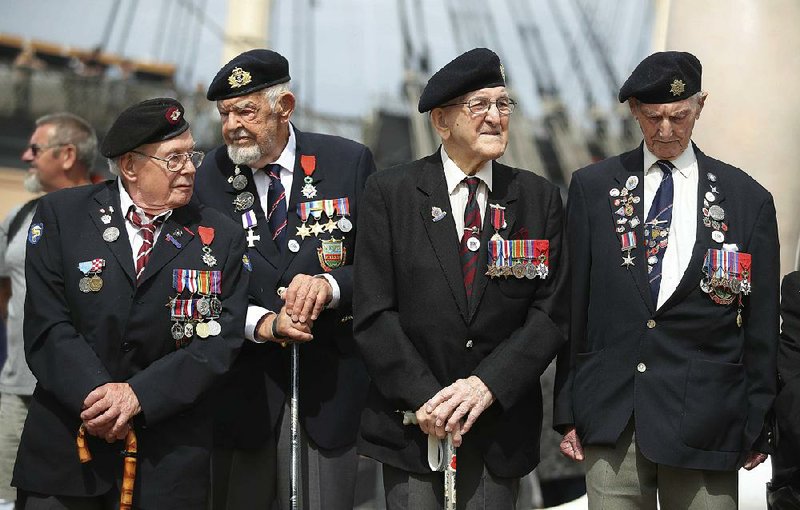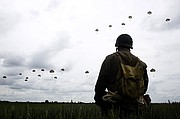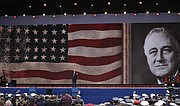World leaders and World War II veterans observed the eve of the 75th anniversary of the Allied invasion of Normandy on Wednesday, with a moving ceremony that wove together firsthand accounts of the day with rousing music and reflections.
The commemoration at the British naval base in Portsmouth, England -- a crucial site for Operation Overlord, the campaign to retake Europe from the Axis powers in World War II -- began with a video montage of elderly veterans who recounted harrowing tales of the invasion on June 6, 1944.
Ten aging veterans of the battle slowly shuffled across the stage, some walking with the aid of canes, as the crowd rose in applause.
President Donald Trump and first lady Melania Trump sat alongside Queen Elizabeth II and Prince Charles for the ceremony, as a parade of actors, politicians and members of the military took to the stage.
Prime Minister Theresa May, Chancellor Angela Merkel of Germany, and other European leaders were also in attendance, as were more than 300 veterans of the military operation and their families.
Portsmouth played an important part in the D-Day operation: Allied forces boarded ships bound for France at the port; Americans lodged in a barracks in the city; and wounded soldiers were treated at one of the city's hospitals.
The event began with a formal procession of British navy, army and air force honor guards and the Welsh Guards, marching through the crowd in tight lines.
After the troops took the stage and presented arms, Queen Elizabeth made her formal entry and stood next to Trump as a chorus delivered a rousing rendition of "God Save the Queen."
The queen, who served as an army mechanic during the war, said that when she attended a 60th-anniversary commemoration of D-Day 15 years ago, many thought it might be the last such event.
"But the wartime generation -- my generation -- is resilient," she said.
"The heroism, courage and sacrifice of those who lost their lives will never be forgotten," the monarch said. "It is with humility and pleasure, on behalf of the entire country -- indeed the whole free world -- that I say to you all, thank you."
Later, Trump took the stage and read an excerpt from a prayer that President Franklin D. Roosevelt read to the nation on the radio the eve of the D-Day operation.
Trump, with images of an American flag and Roosevelt projected behind him, read to the crowd, "Almighty God, our sons, pride of our nation, this day, have set upon a mighty endeavor, a struggle to preserve our republic, our religion and our civilization and to set free a suffering humanity."
May read a letter written by Capt. Norman Skinner of the Royal Army Service Corps to his wife, Gladys, on June 3, 1944, a few days before the invasion. He was killed the day after D-Day.
"Although I would give anything to be back with you, I have not yet had any wish at all to back down from the job we have to do," he wrote.
French President Emmanuel Macron read from a letter sent by a young resistance fighter, Henri Fertet, before he was executed at the age of 16.
"I am going to die for my country. I want France to be free and the French to be happy," it said.
Military bands played somber music as black-and-white film clips were broadcast from the stage showing the faces of young men running onto beaches and readying to jump out of planes. There was also a dance routine featuring the 1941 Andrews Sisters hit "Boogie Woogie Bugle Boy."
Across the Channel, American and British paratroopers dropped into northwestern France and scaled cliffs beside Normandy beaches, re-enacting the daring, costly invasion that helped liberate Europe from Nazi occupation.
The ceremony ended with singer Sheridan Smith performing the wartime hit "We'll Meet Again," as many of the elderly assembled veterans sang along.
Then WWII Spitfire fighters and Hurricane fighter jets, modern-day Typhoons and the Royal Air Force's Red Arrows aerobatic unit swooped over the dignitaries, veterans and large crowd of spectators.
After the event, Trump visited with American World War II veterans who were among Allied troops on D-Day.
BEGINNING OF END
On June 6, 1944, about 7,000 naval vessels, including battleships, destroyers and assault craft, attacked German positions on the Normandy coast and landed more than 132,000 ground troops on the beaches.
Historians consider the D-Day invasion "the beginning of the end of the war" and stress that it was an international effort. The fighting in Normandy went on for a month.
Arthur Hampson turned 93 on Wednesday. On D-Day, he was an 18-year-old midshipman ferrying Canadian soldiers and Sherman tanks to Juno Beach, one of the five landing beaches in Normandy. They successfully landed four of the tanks, but one fell into the sea, and two crew members drowned.
Hampson said: "I don't regard myself as a hero. We had a job to do. We didn't want to let anyone down. But we also didn't want to die." He said that if he were shot, he hoped the bullet would go clean through and kill him.
He returned to Portsmouth that night and sipped a quiet pint in a pub. He recalled thinking to himself, "I can't believe what we'd gone through that day."
Les Hammond, 94, landed at Juno Beach with the Royal Electrical Mechanical Engineers. "What happened to me is not important. I'm not a hero. I served with men who were," he said. "I'm very lucky I'm a survivor."
John Jenkins, 99, was with the Royal Pioneer Corps when he landed at Gold Beach. He recalled digging holes in the ground to get a few hours of sleep and being ever worried about treading on mines. When it came to fear, "You didn't show it, but you felt it."
He said "young people today need to know what happened, because if it didn't happen, they'd all be wearing swastikas today."
Jenkins added that "Trump was most welcome" at the commemorations. "I know the Americans didn't come into it until a bit later, but they did do their part," he said.
Some of the hardest fighting on D-Day was done by U.S. troops at Omaha Beach, where about 2,000 of them died. An additional 238 U.S. airborne troops were killed dropping into enemy territory behind the landing beaches.
For the D-Day anniversary itself today, Trump plans to go to northern France.
Events in France began early Wednesday with U.S. Army Rangers climbing the jagged limestone cliffs of Normandy's Pointe du Hoc to honor the men who scaled them under fire 75 years ago.
They were re-enacting a journey taken in 1944 by the U.S. Army's 2nd and 5th Ranger Battalions to destroy Nazi guns atop the cliffs, helping prepare the way for Allied troops to land on the coast.
Elsewhere in Normandy, parachutists jumped from C-47 transporters in WWII colors and other aircraft, aiming for fields of wild flowers on the outskirts of Carentan, one of the early objectives for Allied troops.
Among the jumpers was American D-Day veteran Tom Rice, 97. He jumped into Normandy with thousands of other parachutists in 1944 and recalled it as "the worst jump I ever had."
Like many other veterans, Rice said he remains troubled by the war.
"We did a lot of destruction, damage. And we chased the Germans out and coming back here is a matter of closure," he said. "You can close the issue now."
Information for this article was contributed by staff members of The New York Times; by Danica Kirka, Jill Lawless, John Leicester, Milos Krivokapic, Gregory Katz, Kevin Freking, Jonathan Lemire, Darlene Superville and Deb Riechmann of The Associated Press; and by William Booth and Karla Adam of The Washington Post.
A Section on 06/06/2019



